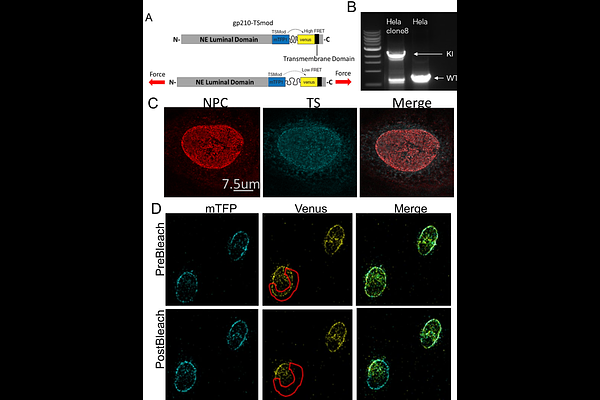A novel FRET-force biosensor for nucleoporin gp210 reveals that the nuclear pore complex experiences mechanical tension

A novel FRET-force biosensor for nucleoporin gp210 reveals that the nuclear pore complex experiences mechanical tension
Wang, P.; Denis, K.; Luxton, G. G.; Conway, D. E.
AbstractThe nuclear pore complex (NPC) is a large multi-protein structure that enables movement of macromolecules, such as mRNA and proteins, between the nucleoplasm and cytoplasm. There has been great interest in how the physical state of the NPC can influence nuclear-cytoplasmic transport. The hypothesis that the NPC may be mechanosensitive is supported by prior reports showing that the diameter of the NPC increases with nuclear envelope stretch as well as increased ECM stiffness. We therefore sought to develop a biosensor-based approach to determine if the NPC experiences mechanical tension. Using a previously developed FRET-force biosensor, known as TSmod, we developed a gp210 tension sensor. gp210 is a transmembrane nucleoporin, which may serve to anchor the NPC into the nuclear envelope. Using a CRISPR knock-in strategy, we developed a HeLa cell line which expresses the gp210 tension sensor at endogenous levels. Using this sensor, we observed that gp210 forces increase in response to osmotically induced nuclear swelling. Cell attachment, ECM stiffness, the nuclear LINC complex, chromatin condensation, and actomyosin contractility were all observed to influence gp210 forces. Surprisingly, gp210 forces were increased with chromatin relaxation and myosin light chain kinase inhibition, indicating that NPC forces may be differentially regulated from forces on the LINC complex. Our data support a hypothesis where nuclear strain, rather than cytoskeletal forces, is the predominant source for NPC forces. Our studies demonstrate that NPC proteins do experience mechanical tension. We anticipate that the gp210 force sensor will be of use for future studies of NPC mechanobiology.